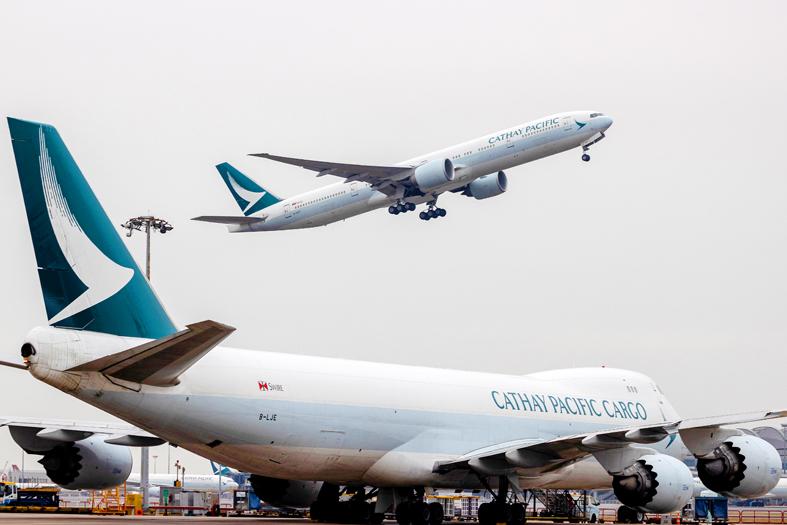Hong Kong carrier Cathay Pacific Airways Ltd (國泰航空) yesterday said it suffered a record US$2.8 billion loss last year as the COVID-19 pandemic wiped out demand for travel — and the airline warned of a long road to recovery ahead.
Cathay chairman Patrick Healy described last year as the “most challenging” in the airline’s 70-year history and said much would depend on how effective and widespread global vaccination programs are.
“It is by no means clear how the pandemic and its impact will develop over the coming months,” he said, adding that the group expected passenger traffic to remain “well below” half of pre-pandemic levels throughout this year.

Photo: EPA-EFE
The company’s losses were higher than estimates compiled by Bloomberg News.
Cathay racked up an attributable loss of HK$21.6 billion (US$2.8 billion) for last year, going deeper into the red as the year wore on.
Its second-half losses clocked in at HK$11.8 billion, up from HK$9.9 billion in the first six months of last year when the pandemic first emerged.
As the pandemic spread, the airline went on a cost-cutting spree, closing its Cathay Dragon (國泰港龍) subsidiary, making about 8,500 redundancies and slashing executive pay.
With the help of a government bailout Cathay underwent a recapitalization in July last year that raised HK$39 billion.
However, passenger numbers have been about 98 percent below pre-pandemic levels since April, and for much of last year the company was burning through cash at a rate of up to HK$1.5 billion a month.
By the end of last year, Cathay’s shares had fallen 29 percent.
In yesterday’s annual report, Cathay said it had managed to reduce the cash burn toward the end of the year, but longer quarantine restrictions that Hong Kong placed on all long-distance flight crew in January was now canceling out most of those savings.
Cathay said it would keep executive pay slashed and ask staff to go on a third round of unpaid leave — to which about 80 percent of employees have already signed up.
Its liquidity at the end of last year was HK$28.6 billion and Cathay also issued HK$6.74 billion in convertible bonds in January to secure more funds.
Hong Kong managed to keep COVID-19 infections comparatively low by bringing in strict quarantine measures for all arrivals early on in the pandemic.
Currently, most of those arriving in the territory must quarantine in a hotel for 21 days, one of the longest mandatory quarantine periods in the world. Outbound travel is almost non-existent, and there is little sign of those measures being lifted any time soon.
Last week, the head of Hong Kong’s tourist board said it could be at least six months before residents would be able to travel again.

To many, Tatu City on the outskirts of Nairobi looks like a success. The first city entirely built by a private company to be operational in east Africa, with about 25,000 people living and working there, it accounts for about two-thirds of all foreign investment in Kenya. Its low-tax status has attracted more than 100 businesses including Heineken, coffee brand Dormans, and the biggest call-center and cold-chain transport firms in the region. However, to some local politicians, Tatu City has looked more like a target for extortion. A parade of governors have demanded land worth millions of dollars in exchange

Hong Kong authorities ramped up sales of the local dollar as the greenback’s slide threatened the foreign-exchange peg. The Hong Kong Monetary Authority (HKMA) sold a record HK$60.5 billion (US$7.8 billion) of the city’s currency, according to an alert sent on its Bloomberg page yesterday in Asia, after it tested the upper end of its trading band. That added to the HK$56.1 billion of sales versus the greenback since Friday. The rapid intervention signals efforts from the city’s authorities to limit the local currency’s moves within its HK$7.75 to HK$7.85 per US dollar trading band. Heavy sales of the local dollar by

Taiwan Semiconductor Manufacturing Co’s (TSMC, 台積電) revenue jumped 48 percent last month, underscoring how electronics firms scrambled to acquire essential components before global tariffs took effect. The main chipmaker for Apple Inc and Nvidia Corp reported monthly sales of NT$349.6 billion (US$11.6 billion). That compares with the average analysts’ estimate for a 38 percent rise in second-quarter revenue. US President Donald Trump’s trade war is prompting economists to retool GDP forecasts worldwide, casting doubt over the outlook for everything from iPhone demand to computing and datacenter construction. However, TSMC — a barometer for global tech spending given its central role in the

An Indonesian animated movie is smashing regional box office records and could be set for wider success as it prepares to open beyond the Southeast Asian archipelago’s silver screens. Jumbo — a film based on the adventures of main character, Don, a large orphaned Indonesian boy facing bullying at school — last month became the highest-grossing Southeast Asian animated film, raking in more than US$8 million. Released at the end of March to coincide with the Eid holidays after the Islamic fasting month of Ramadan, the movie has hit 8 million ticket sales, the third-highest in Indonesian cinema history, Film